

93, 098107 (2004): Emergence of Prime Numbers as the Result of Evolutionary Strategy. We investigate by means of a simple theoretical model the emergence of prime numbers as life cycles, as those seen for some species of cicadas.
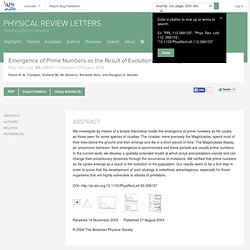
The cicadas, more precisely the Magicicadas, spend most of their lives below the ground and then emerge and die in a short period of time. The Magicicadas display an uncommon behavior: their emergence is synchronized and these periods are usually prime numbers. In the current work, we develop a spatially extended model at which preys and predators coexist and can change their evolutionary dynamics through the occurrence of mutations. Population dynamics. Cicadas of the genus Magicicada appear every 7, 13 or 17 years.

The fact that these are prime numbers has been regarded as a coincidence. We developed a model with predators (X) and prey (Y) including mutations and selection. We showed that prey (cicadas) with prime cycles are selected (see example a) below) in order to optimally escape predators. Changing our intentions from biological to number-theoretical, we set arbitrarily large initial conditions and could thus use this model as a generator for very large prime numbers (for example, in the figure b) below, the Euler-prime E is selected).
Predator satiation. Predator satiation (less commonly called predator saturation) is an antipredator adaptation in which prey occur at high population densities, reducing the probability of an individual organism being eaten.[2] When predators are flooded with potential prey, they can consume only a certain amount, so by occurring at high densities prey benefit from a safety in numbers effect.
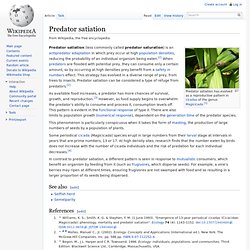
This strategy has evolved in a diverse range of prey, from trees to insects. Predator satiation can be considered a type of refuge from predators.[2] As available food increases, a predator has more chances of survival, growth, and reproduction.[3] However, as food supply begins to overwhelm the predator's ability to consume and process it, consumption levels off. This pattern is evident in the functional response of type II. There are also limits to population growth (numerical response), dependent on the generation time of the predator species. See also[edit] References[edit] A fascinating little beastie. Back in 2004 I was living in New York and commuting between New York and Washington, DC on the Acela.
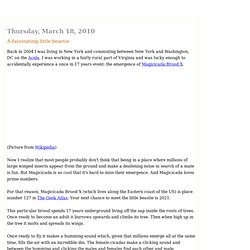
I was working in a fairly rural part of Virginia and was lucky enough to accidentally experience a once in 17 years event: the emergence of Magicicada Brood X. (Picture from Wikipedia) Now I realize that most people probably don't think that being in a place where millions of large winged insects appear from the ground and make a deafening noise in search of a mate is fun.
But Magicicada is so cool that it's hard to miss their emergence. And Magicicada loves prime numbers. For that reason, Magicicada Brood X (which lives along the Eastern coast of the US) is place number 127 in The Geek Atlas. This particular brood spends 17 years underground living off the sap inside the roots of trees. Once ready to fly it makes a humming sound which, given that millions emerge all at the same time, fills the air with an incredible din. There are other cicadas that live on a 7 and 13 year cycle. Nature's hidden prime number code. 27 July 2011Last updated at 10:25 Prime numbers are found hidden in nature, but humans have made spectacular use of them, writes mathematician Marcus du Sautoy.
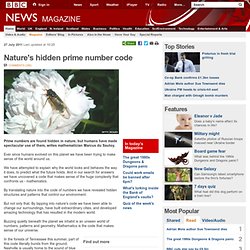
Ever since humans evolved on this planet we have been trying to make sense of the world around us. We have attempted to explain why the world looks and behaves the way it does, to predict what the future holds. And in our search for answers we have uncovered a code that makes sense of the huge complexity that confronts us - mathematics. By translating nature into the code of numbers we have revealed hidden structures and patterns that control our environment. But not only that. Buzzing quietly beneath the planet we inhabit is an unseen world of numbers, patterns and geometry. In the forests of Tennessee this summer, part of this code literally bursts from the ground.
But every 13 years, the banjos and basses get drowned out for six weeks by the chorus of an insect that has fascinated me ever since I became a mathematician. Prime number selection of cycles in a predator-prey model - Goles - 2001 - Complexity. Examples of prime numbers in nature. Nontrival primes: human chromosome number is 23, Sunflower chromosome number is 17, both of which are prime.
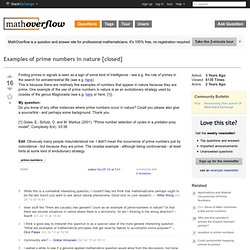
Most flowers have an odd and often prime number of petals: five is a common number. I assume you really meant non-trivial primes, where p>2 or p>3, but you didn't specify that, so let me point out some basic regions where 2 and 3 are prominent. And 2 and 3 are very prominent through-out nature, so these are not very special concepts. Diploid genomes come in copies of 2, and 2 is prime. DNA chains come in duplicate copies, with one side reading in one direction as the sense and the other side being the "inverted carbon copy" and called the nonsense side.